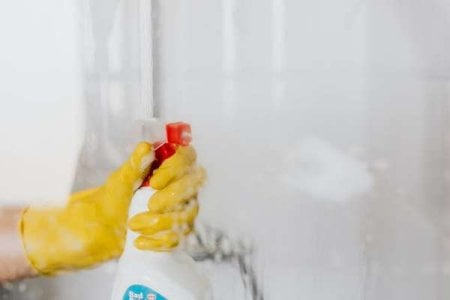Are you making these dangerous cleaning mistakes? Experts reveal the safest and effective way to scrub your shower and toilet!
By
Danielle F.
- Replies 0
Let’s be honest—cleaning the bathroom is hardly anyone’s idea of a good time. But as much as we might dread the task, it’s one of those necessary evils that keeps our homes healthy and sparkling. However, did you know that many of us are actually making some pretty risky mistakes when it comes to scrubbing our showers and toilets? Not only could these blunders be damaging your expensive fixtures, but they might also be putting your health—and your family’s—at risk.
So, before you don the rubber gloves and reach for your arsenal of sprays and scrubs, let’s take a closer look at what the experts have to say about the right (and wrong!) way to clean your bathroom.
The Hidden Dangers Lurking in Your Cleaning Routine
According to John Horner, Managing Director at luxury bathroom company 34 St John, the most common mistake people make is mixing cleaning products together in the hope of creating a 'super cleaner.' It might sound like a clever shortcut, but in reality, it’s a recipe for disaster.
'People believe that combining products will tackle stubborn stains better,' Horner explains. 'But this actually creates toxic fumes that can cause serious respiratory issues and damage delicate finishes on premium fittings.'
The worst offenders? Mixing bleach with vinegar-based cleaners or ammonia products. This combination can produce chlorine gas—a highly toxic substance that irritates the respiratory system and can lead to severe health problems. The UK Health Security Agency also warns: 'Avoid mixing cleaning products together as this can create toxic fumes.'
And if your bathroom is poorly ventilated (as many are), those dangerous vapours can quickly build up, making things even worse. Always open windows and run exhaust fans during and after cleaning to help clear the air and prevent moisture build-up, which can lead to mould behind your fixtures.
Don’t Ruin Your Fixtures—Gentle Is Best
Another common mistake is using abrasive cleaners or harsh scrubbing pads on specialty finishes. Many modern taps and fittings feature beautiful coatings like brushed nickel or oil-rubbed bronze, which can be permanently scratched or dulled by rough treatment.
'For most premium finishes, warm water with mild soap applied with a soft cloth offers effective cleaning without damage,' Horner advises. So, put down the steel wool and reach for something gentler—you’ll thank yourself later when your bathroom still looks brand new years down the track.
The Surfaces You’re Probably Forgetting
We all know to give the toilet bowl a good scrub, but what about the spots we touch the most? Door handles, light switches, and tap handles are some of the most bacteria-laden surfaces in the bathroom, yet they’re often overlooked during routine cleaning.
'People focus on visibly dirty areas like toilets while overlooking touch points that transfer germs most readily,' Horner points out. Make it a habit to wipe these areas daily with an appropriate cleaner—your immune system will thank you!
Where You Store Your Cleaning Products Matters
It might seem logical to keep your cleaning supplies under the bathroom sink, but this can actually cause problems. The warm, humid environment can degrade the effectiveness of your products, and being close to water sources increases the risk of accidental spills or chemical reactions.
If possible, store your cleaning products in a cool, dry place outside the bathroom, and always keep them out of reach of children and pets.
Protect Yourself—And Your Skin
Don’t forget to look after yourself while you’re looking after your bathroom! Always wear protective gloves when handling cleaning products, as repeated exposure can cause skin irritation or even allergic reactions.
A Little Every Day Goes a Long Way
Finally, here’s a tip that might just make bathroom cleaning feel a little less daunting: instead of waiting for grime to build up and then launching into a marathon 'deep clean,' try doing a light clean every day. Wipe down surfaces, give the toilet a quick once-over, and keep on top of soap scum in the shower. This approach prevents build-up and means you’ll rarely need to resort to harsh chemicals or heavy scrubbing.
Bonus Tips for a Safer, Fresher Bathroom

We’d love to hear from you, members! Have you ever accidentally mixed cleaning products, or discovered a clever trick for keeping your bathroom sparkling? What’s your least favourite bathroom chore? Share your stories, tips, and questions in the comments below—let’s help each other keep our homes safe, healthy, and squeaky clean!
So, before you don the rubber gloves and reach for your arsenal of sprays and scrubs, let’s take a closer look at what the experts have to say about the right (and wrong!) way to clean your bathroom.
The Hidden Dangers Lurking in Your Cleaning Routine
According to John Horner, Managing Director at luxury bathroom company 34 St John, the most common mistake people make is mixing cleaning products together in the hope of creating a 'super cleaner.' It might sound like a clever shortcut, but in reality, it’s a recipe for disaster.
'People believe that combining products will tackle stubborn stains better,' Horner explains. 'But this actually creates toxic fumes that can cause serious respiratory issues and damage delicate finishes on premium fittings.'
The worst offenders? Mixing bleach with vinegar-based cleaners or ammonia products. This combination can produce chlorine gas—a highly toxic substance that irritates the respiratory system and can lead to severe health problems. The UK Health Security Agency also warns: 'Avoid mixing cleaning products together as this can create toxic fumes.'
And if your bathroom is poorly ventilated (as many are), those dangerous vapours can quickly build up, making things even worse. Always open windows and run exhaust fans during and after cleaning to help clear the air and prevent moisture build-up, which can lead to mould behind your fixtures.
Don’t Ruin Your Fixtures—Gentle Is Best
Another common mistake is using abrasive cleaners or harsh scrubbing pads on specialty finishes. Many modern taps and fittings feature beautiful coatings like brushed nickel or oil-rubbed bronze, which can be permanently scratched or dulled by rough treatment.
'For most premium finishes, warm water with mild soap applied with a soft cloth offers effective cleaning without damage,' Horner advises. So, put down the steel wool and reach for something gentler—you’ll thank yourself later when your bathroom still looks brand new years down the track.
The Surfaces You’re Probably Forgetting
We all know to give the toilet bowl a good scrub, but what about the spots we touch the most? Door handles, light switches, and tap handles are some of the most bacteria-laden surfaces in the bathroom, yet they’re often overlooked during routine cleaning.
'People focus on visibly dirty areas like toilets while overlooking touch points that transfer germs most readily,' Horner points out. Make it a habit to wipe these areas daily with an appropriate cleaner—your immune system will thank you!
Where You Store Your Cleaning Products Matters
It might seem logical to keep your cleaning supplies under the bathroom sink, but this can actually cause problems. The warm, humid environment can degrade the effectiveness of your products, and being close to water sources increases the risk of accidental spills or chemical reactions.
If possible, store your cleaning products in a cool, dry place outside the bathroom, and always keep them out of reach of children and pets.
Protect Yourself—And Your Skin
Don’t forget to look after yourself while you’re looking after your bathroom! Always wear protective gloves when handling cleaning products, as repeated exposure can cause skin irritation or even allergic reactions.
A Little Every Day Goes a Long Way
Finally, here’s a tip that might just make bathroom cleaning feel a little less daunting: instead of waiting for grime to build up and then launching into a marathon 'deep clean,' try doing a light clean every day. Wipe down surfaces, give the toilet a quick once-over, and keep on top of soap scum in the shower. This approach prevents build-up and means you’ll rarely need to resort to harsh chemicals or heavy scrubbing.
Bonus Tips for a Safer, Fresher Bathroom
- Ditch the air fresheners: Scientists have found that fumes from bleach can react with chemicals in air fresheners, creating toxic airborne particles called secondary organic aerosols (SOAs). Stick to natural ventilation or a bowl of bicarb soda to keep things smelling fresh.
- Check your product labels: Always read the instructions and warnings on your cleaning products. Some are not meant to be used together, and others may require rinsing or special handling.
- Keep it simple: Sometimes, less is more. Warm water, a bit of mild soap, and a soft cloth can tackle most messes without the need for a chemical cocktail.
Key Takeaways
- Mixing cleaning products, such as bleach with vinegar or ammonia, can produce toxic fumes like chlorine gas that cause serious health risks and damage to bathroom fixtures.
- Using abrasive cleaners on speciality bathroom finishes can permanently scratch and ruin expensive tapware and fittings; gentle soap and water are best for most premium surfaces.
- Neglecting frequently-touched surfaces like door handles, light switches and tap handles allows germs to spread—these should be cleaned daily, not just visibly dirty areas.
- Storing cleaning products under the bathroom sink is risky due to humidity and proximity to water, which can degrade products and increase accident risk; always wear gloves and prioritise regular light cleaning over occasional deep cleans.








